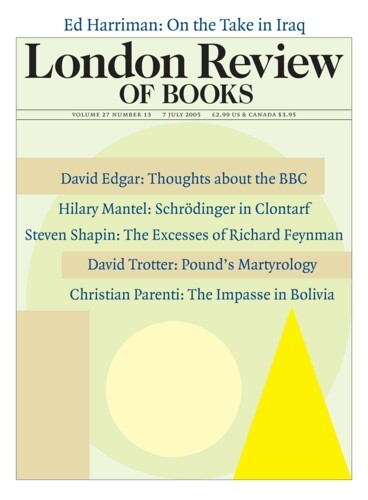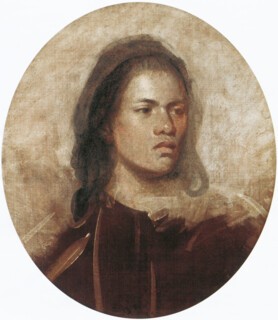The Joshua Reynolds exhibition at Tate Britain (until 18 September) is subtitled ‘The Creation of Celebrity’. The case for Reynolds as a prime mover in the invention of that modern kind of fame is well made. The catalogue, the wall labels, the little cards with short quotations set in fancy borders which are stuck below some of the pictures, all these help fill out what can be read from the paintings themselves: that Reynolds, in his seven-hours-a-day, seven-days-a-week pursuit of reputation, fame and wealth, and in his ardent prosecution of his role as a maker of iconic portraits, not only made likenesses of distinguished literary men, successful courtesans, noblemen, royalty and friends (especially friends, because many of the great and many of the scandalous were also his friends), but gave them a dignity, winsomeness, beauty or authority which the imagination of a literate public, fed with gossip and news from a burgeoning press, recognised and relished.
No painter today could do it. Photography has so far subdued the power of painting to embellish personality that when Lucian Freud (who in his prices, subjects and reputation is the closest thing we have to a dominant face-painter of Reynolds’s calibre) paints the Queen (as Reynolds painted the Prince of Wales) or Kate Moss undressed (as Reynolds painted Kitty Fisher), it is not the power of his canvases to match the glamour evoked by the written and spoken word which first strikes us, but their resemblance or lack of it to photographs – very often to photographs posed with turns of the head and flounces which go back to Reynolds’s portraits. Photographs which we can’t help knowing already condition our first responses and, insofar as we are participants in that cult of celebrity which reaches its early maturity in Reynolds’s work, those first responses may also be our last.
Celebrity portraits may have another more profound, or at least more dignified life as works of art, but our problem when we look at them in that way is the encroachment of the publicity images which accompany them in our memories. A Reynolds exhibition presents an analogous but different problem: when you have subtracted from one of his portraits the clever presentation which made it work as great publicity, does what is left add up to a great work of art?
One of the admirable aspects of this exhibition is the space and attention given to prints. The mezzotints shown here did much to spread Reynolds’s reputation; they are also achievements in their own right. To some degree they make up for the fact that Reynolds’s two thousand-odd portraits are not, on the whole, wonderful pieces of craft. The paintings couldn’t have been achieved without the help of drapery painters and other assistants, and while they hold together visually when seen from a distance they do not usually come alive a second time (as Gainsborough expected his to) when you move towards them and read the surface as a field of individual marks. Lesser painters who were his contemporaries or near-contemporaries – Raeburn, for example, and Lawrence – outdid him in suave surfaces and ease of performance. This lack of painterly grace, along with his notorious use of fugitive pigments and doubtful drying agents, undermines the seriousness announced by his writings, his advancement of the social position of artists and his place in the world of learning and affairs.
The show, to a degree, gives the lie to the sternest critics of his technique by demonstrating that it is possible to display a collection of his works in which most of the faces are convincingly blooming or ruddy and not all the picture surfaces are cracked or disintegrating. But if the artist is to be separated from the publicist, or if the work of the publicist is to be given the attention due to a man who celebrated rather than just flattered the people he painted, we must take account of a view of the art of painting which is now hard to think one’s way into, and which, incidentally, never proved able to achieve what Reynolds hoped it would: a national school of painting based on sound principles and drawing on the example of the greatest of the Italians. We must also acknowledge, as Reynolds did himself, that his practice was some distance from the theory he developed in the Discourses. The notion that ideal beauty can be pursued rationally and that the example of the masters is the foundation on which new art must rise was not entirely ignored by Reynolds as he saw to the needs of the patrons of modern portraiture. When he paints the courtesan Emily Warren in the guise of Thaïs, or the Marquis of Granby, a soldier, in the pose of a sculpture of Hercules, he is putting into practice his belief that painting, too, has classics which can be quoted from.
The prints, oddly enough, seem closer to his theoretical ideals than his paintings, as well as more coherent and more authoritative. Of all the processes of graphic reproduction, mezzotint is most like painting and least like drawing. A copper plate is first roughened all over with a toothed rocker. An impression taken at that stage is perfectly, evenly black. The engraver, working in negative, scrapes and burnishes away the highlights and mid-tones. The gradations achieved, the soft transitions from light to shade, the wonderful sooty blackness of the darkest parts of the image, all delectable in their own right, proved to be perfect for getting Reynolds’s portraits onto paper. The best of these prints correct what is uneven and give equal attention to the whole field. Unlike, for example, Hogarth before him and Frith after him, he made no money from engravings: it was the publicity they brought which was invaluable. Some were not even commercial, but commissioned by sitters to pass on to friends. Mezzotint was not, in any case, a suitable medium for the very long commercial runs which made fortunes for other painters. Although the plates could be prepared comparatively quickly (line engravings could be months or even years in the making) after fifty or so impressions the burr began to be flattened by the pressure of the press. The prints in the exhibition still feel like the luxury product they always were.
Reynolds’s genius was, when he wrote, cerebral. In the Discourses he set out ideas about the education of artists and about painting which, he acknowledges, were not those that had governed his own practice. Yet his art, like his writing, is calculated rather than instinctive. His travels in Italy and his knowledge of classical and Italian art were the basis of the variety in composition and expression which distinguishes the body of his work as a portrait-painter from that of his contemporaries. What stands between him and the dignity of the high art he so much admired – above all that of Raphael and Michelangelo – and what also saves him from intolerable pomposity, is his theatrical streak. Almost everyone who is not literally in fancy dress is nonetheless playing a part; the very greatest portraits, from the Mona Lisa on, are famously demanding of interpretation. Reynolds’s soldiers are just heroic, his actresses just tragic or merely playful; Dr Johnson is given the gravitas of a Roman portrait bust. Some women preferred to be painted by Gainsborough because he let them wear modern clothes. Reynolds, who found modern dress, particularly in sculpture, unartistic, tended to suggest quasi-classical drapery – that is how he dressed Omai, the Polynesian brought to London from Tahiti in 1774. One of the most intriguing pictures in the exhibition is this study of Omai, which shows how far Reynolds was willing to go to make a portrait match an ideal. It is not just the turban and drapery which are un-Tahitian in the final portrait, it is the face itself. The nose, one realises when one looks at the convincingly Polynesian face of the study, should be flatter and less turned up, the mouth more sullen. The study has the kind of truth which only those who turn their back on the ideal achieve. This is not a fantasy Noble Savage but a candidate for a Pacific island rugby team’s front row.
Send Letters To:
The Editor
London Review of Books,
28 Little Russell Street
London, WC1A 2HN
letters@lrb.co.uk
Please include name, address, and a telephone number.


